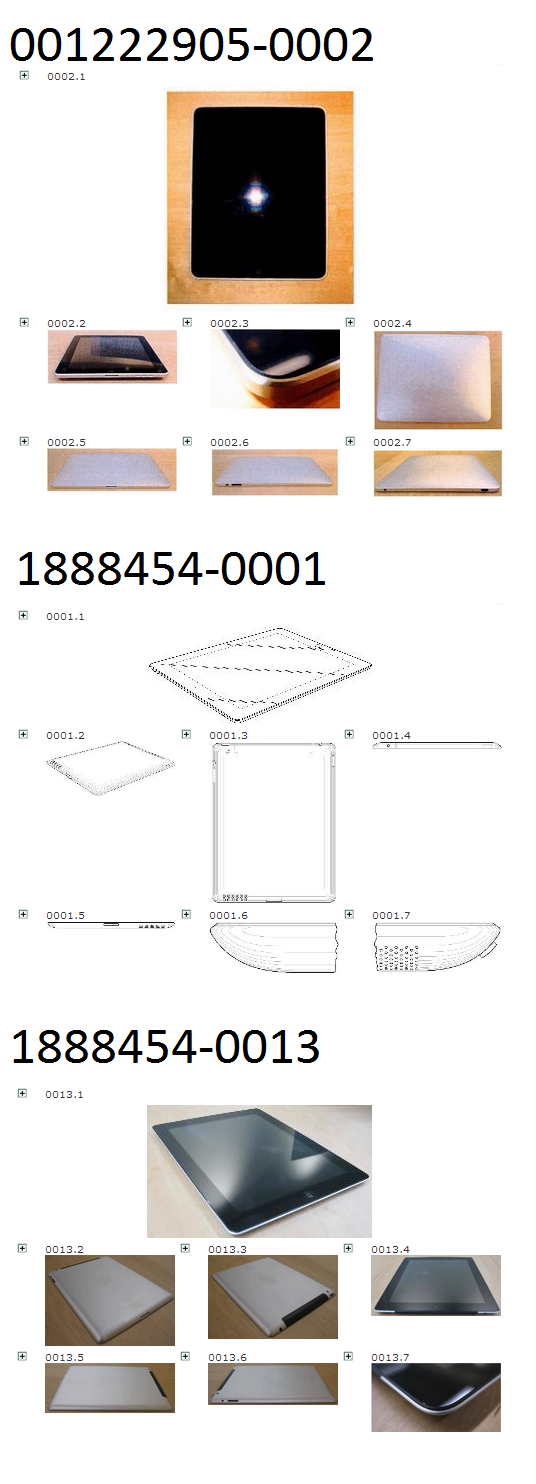Twee iPad 2-modelrechten ongeldig
Beslissingen ingezonden door Laurens Kamp, Simmons & Simmons LLP.
OHIM Invalidity Division, ICD 8683 (Samsung c.s. tegen Apple)
 Het verzoek voor nietigverklaring van het model met nummer 001222905-0002 (fotoweergave van iPad 2) is afgewezen. De nietigheidsgronden ex artikel 25 lid 1 sub a en b zijn ongegrond. Een 52-pagina's-tellende beslissing:
Het verzoek voor nietigverklaring van het model met nummer 001222905-0002 (fotoweergave van iPad 2) is afgewezen. De nietigheidsgronden ex artikel 25 lid 1 sub a en b zijn ongegrond. Een 52-pagina's-tellende beslissing:
Disclosure - (86) Where the designs are disclosed in a front or perspective view, and a side view allows the shape or contours of the back part of the product to be determined, or there is a back view, such disclosures are considered sufficient to make the assessment of novelty and individual character.
Technical function - (93) For the reasons given above none of the features appointed by the Applicants (flat display, slim profile, shape, rounded corners, functional elements or camera) are considered being solely dictated by the technical function pursuant to Article 8(1) CDR.
OHIM Invalidity Division, ICD 8720 (Samsung c.s. tegen Apple)
Het model 1888454-0013 (fotoweergave iPad 2) is nietig verklaard vanwege het gebrek aan eigen karakter.
(63) The portable device is supposed to be easily handled, carried, held, placed in bags and easily transported, etc. The user uses the device as such, not only its screen when placed on a flat surface. Thus, the informed user, as particularly observant, takes into consideration not only the front part of the device, though it is the part of the product which allows its functioning.
OHIM Invalidity Division, ICD 8721 (Samsung c.s. tegen Apple)
Het model 1888454-0001 is nietig verklaard vanwege het gebrek aan eigen karakter.
Uit ICD 8720:
(61) In the present case the informed user is familiar with designs of portable display devices. S/he is aware of the designs of products which were available before the date of priority of the contested RCD and s/he is aware of constraints of the designer's freedom given by technical requirements and the function of the device.
(62) The device has to be portable; it requires a screen to display information and some functional elements to be operated. Portable display devices can significantly differ in size, ranging from the size of mobile phones to the size of laptops, and they can differ in the ratio of the sides. The screen of the device is expected to have a display and to be rectangular, although the division of the screen or application of some borders around the screen is not dictated by severe constraints. Market tendencies such as aesthetic or commercial considerations, as argued by the Applicants in connection with flat screens, are not regarded as restrictions to the freedom of the designer (see judgment of 22/06/2010, T-153/08, 'Communication unit', paragraph 58).
(63) The portable device is supposed to be easily handled, carried, held, placed in bags and easily transported, etc. The user uses the device as such, not only its screen when placed on a flat surface. Thus, the informed user, as particularly observant, takes into consideration not only the front part of the device, though it is the part of the product which allows its functioning. When making a choice at the time of purchase of the product, the informed user also considers the casing and the overall shape, and s/he is able to differentiate between different products on the market. What matters is not only the functional part of the device but also the shape and design of the body of the device. The informed user is particularly attentive due to the saturation of the market in the given field, which was considerably high before the date of priority of the RCD, as follows from numerous examples of submitted prior art by the Applicants. The density in the given field makes the informed user more sensitive to the differences between products with the same or similar function (see judgment of 13/11/2012, T-83/11, 'Radiators for heating', paragraph 81). The user is attentive even to small differences between the designs.
(65) The RCD is registered for a particular shape of the portable display device. Comparing the prior and the contested designs, they are almost identical in the front side, where the only difference is the shape of the home button. The designs differ in the angle in which the side walls of casing are bevelled toward the back but the contours of the casing are not very different. Though the prior design is not disclosed in a side view, from the provided images it is quite clear that it is slim rather than robust. The contested RCD has the functional elements on its sides which are missing in the prior design, however the overall impressions produced by the two opposing designs on the informed user are the same. The RCD does not have individual character with respect to the prior design.





















































































